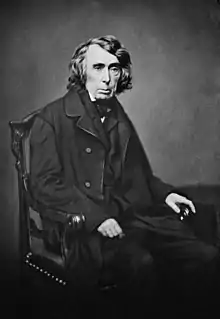Jones v. Van Zandt
Jones v. Van Zandt, 46 U.S. (5 How.) 215 (1847), was a landmark United States Supreme Court decision involving the constitutionality of slavery. John Van Zandt was an abolitionist who aided the Underground Railroad resistance movement in Ohio after having been a slaveholder in Kentucky. Sued for monetary damages by a slaveholder whose escaped slaves he aided, abolitionists used Van Zandt's Supreme Court appeal as a vehicle to reach the underlying constitutional question. Van Zandt lost; the Court, then led by Chief Justice Roger Taney, upheld the right of Congress and the obligation of the government to protect slavery, as it was established under the Constitution. Van Zandt was ruined financially by the decision and died later that year.
| Jones v. Van Zandt | |
|---|---|
 | |
| Decided March 5, 1847 | |
| Full case name | Wharton Jones v. John Van Zandt |
| Citations | 46 U.S. 215 (more) |
| Court membership | |
| |
| Case opinion | |
| Majority | Woodbury, joined by unanimous |
External links
- Text of Jones v. Van Zandt, 46 U.S. (5 How.) 215 (1847) is available from: Google Scholar Justia Library of Congress OpenJurist
This article is issued from Wikipedia. The text is licensed under Creative Commons - Attribution - Sharealike. Additional terms may apply for the media files.
